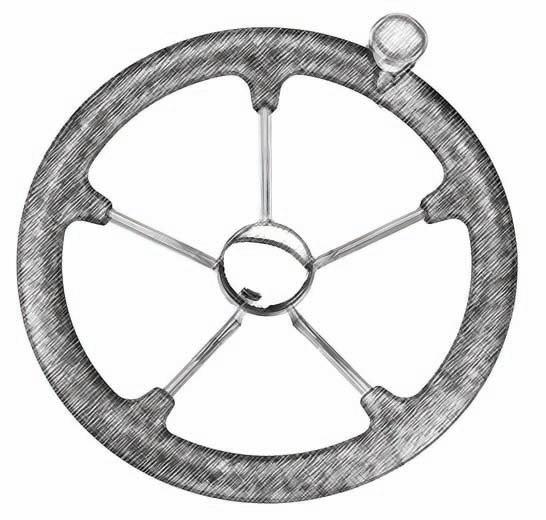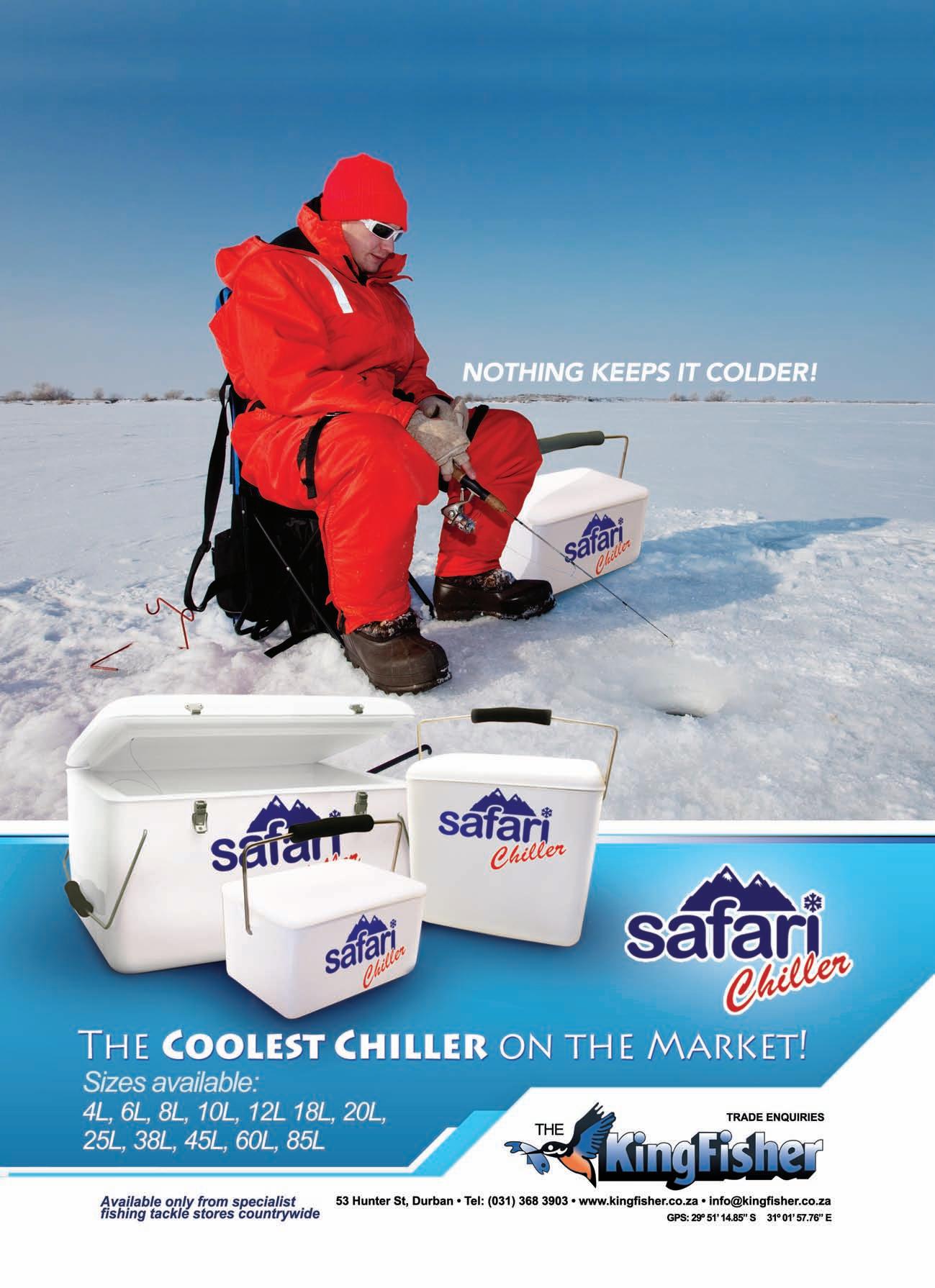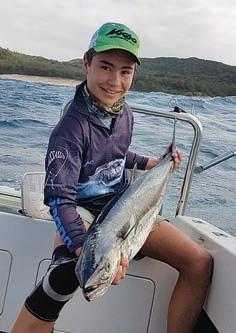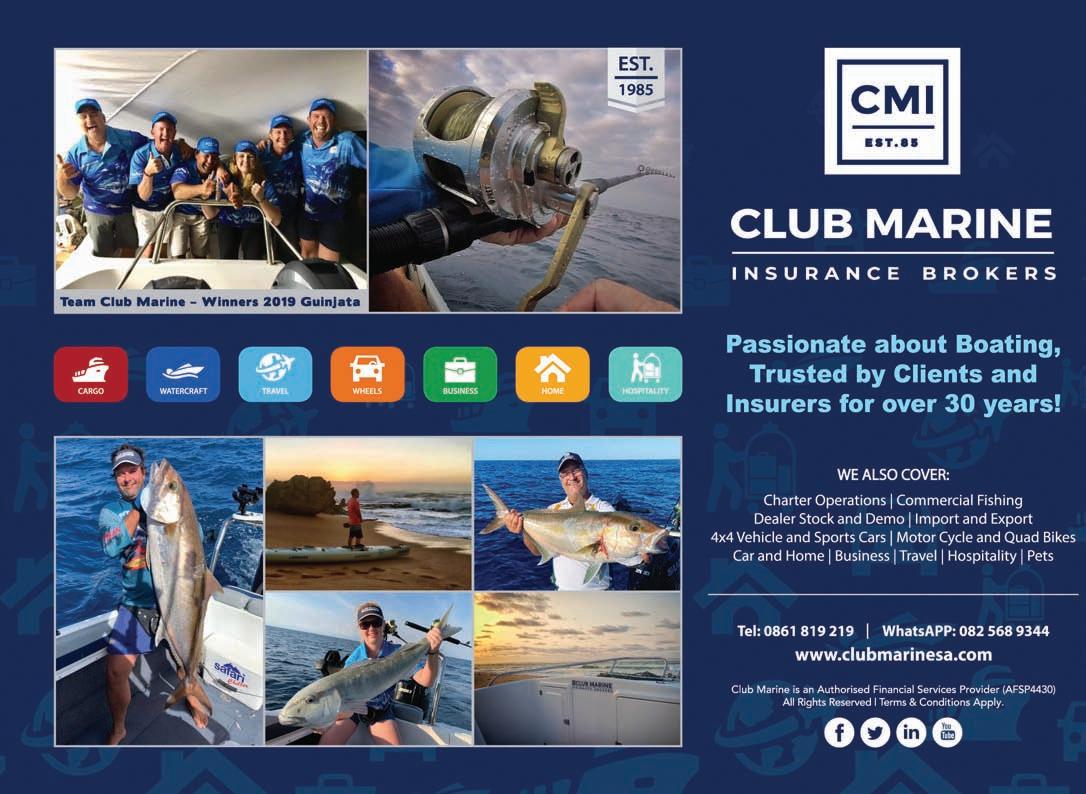
12 minute read
Taking the Helm
When juniors get going there’s no stopping them

Advertisement
By Dylan Westoby M Y passion for fishing started at a very young age. My first trip to sea was off Port Edward with my dad, James, and my grandfather, Tony, when I was six. I caught a nice bull dorado that day and I’ve been hooked ever since.
I have had many incredible fishing days since then and can somehow remember all the finer details of just about every trip. My dad always tells me that there are never two days the same on the boat; there are so many variables and we never know what we are going to get. I guess this is what makes ski-boating and fishing so intriguing.
By the age of 15 I was very fortunate to have a very large collection of trophy fish pictures on my iPhone and lots of very fond memories.
I have always dreamt of one day being able to skipper a boat myself, land a big fish and share the “stoke” with some mates. Fortunately I didn’t have to wait too long. When I turned 16 my birthday present was a skipper’s course with Mike Higgs. I finished writing my final exam at school in the morning and started my skipper’s course that afternoon. I concentrated on everything he told me and passed the exam with ease, becoming a legit Cat B skipper.
Shortly after that we did a trip up to Sodwana. My dad had just done up a 15’ 6” Trimcraft monohull called Lucky Clyde Westoby, Dylan Westoby and Drew Reynolds with their morning’s haul.

Strike and fitted her with a 70hp Suzuki 4-stroke. It’s the ideal little boat for backline fishing and easy to handle on the beach. Unfortunately we were greeted with big surf and not the most ideal conditions for me to “cut my teeth” on, so Dad decided to take the wheel on this occasion. Although I felt confident enough to take the wheel, I realise that one must always respect the sea and not be foolish. We had an amazing trip and caught loads of fish.
A few weeks later we headed for Mozambique. After a very long drive on a sandy road, we eventually arrived at our destination — a very well organised camp in a magnificent bay in southern Mozambique. Brenton Leisegang had invited us to join his family, the Reynolds and the Butchers at his camp for two weeks.
The water was crystal clear, the other boats had come back with some decent couta and the waves were peeling off the point; I didn’t know
whether to pick up my fishing rod or my surfboard. I confess I chose my surfboard this time and had some waves of note.
When we had a closer look at the other boats operating in the area we noticed a lot of damaged props and the odd gearbox around the camp so we had a feeling the launch was a bit rocky. We discovered this reality when we clipped the rocks on our first launch but fortunately no damage was done. After watching a few other boats come in and out we had a better understanding of the channel and managed to avoid the rocks from then on.
After a few outings with my dad and my brother Clyde we had caught a large variety of gamefish and were starting to get to know the area a bit better. Our mates on Moyana had already caught a number of quality crocs so we knew it would soon be our turn.
One morning I woke up asked my dad if I could take the boat out with my brother Clyde and my mate Drew Reynolds to go and catch a croc. Drew had landed a ’cuda close to 20kg the day before so I had a good feeling about my chances. My dad hesitated slightly, and replied,“Ja, okay, but just be careful of the rocks”. I have never got the boat ready that fast in my life!
As we drove over the hill to the launchsite and got a visual of the surf I noticed the backline was a bit “cheeky” and suddenly I felt a little uneasy. After a quick discussion with my dad on the beach, we put on our life jackets, pushed the boat in and idled past the rocks. Once I got into the mid-break a few big sets stood up; I looked back and saw my mom and dad looking on anxiously. After doing two or three circles, I saw my gap and had a safe launch. That feeling of accomplishment was amazing!
The next challenge was to find bait. I headed to the area where the fishing skis had got bait earlier, put the fish finder on and noticed a beautiful showing. We dropped our bait jigs down and were immediately on to full strings of mozzies and mackerel. It didn’t take us long to get a livewell full of decent bait and then we headed to the spot where I thought the crocs would be.
Within minutes of putting our first livey out we were on with a ’cuda. Although it was a small one, there was great excitement and high fives allround. Another successful milestone with me at the helm.
Soon after that I was still letting my livey out when it suddenly screamed off. I knew it was something big, but one minute it was on the surface and then it was deep down with big headnods. I was beginning to think it was a big GT. Eventually we got a visual and it was like a big silver submarine! Suddenly neither Clyde nor Drew wantThe Westoby brothers caught a lovely sailie and a 29.5kg ’cuda on Dylan’s first outing as skipper.


ed to gaff this monster as they didn’t want to be responsible for messing it up, so I said,“No problem, pass me the gaff!”
As the fish did its first turn past the boat I sank the gaff in just behind the
head. I wasn’t expecting the fish to be so feisty, but with one flick of its tail it pulled the gaff out of my hand and screamed off again with the gaff still in it. After calming down to a panic, I managed to get the fish next to the boat again and had a second failed attempt at gaffing it, with the fish pulling the second gaff out my hand. I felt like a matador during a bullfight, trying to slay a wild beast.
We eventually retrieved one of the gaffs and made sure to hold on to it on the third attempt. The fish still had lots of fight in it and thrashed around for a bit before we managed to pull its head up over the gunnel and it flopped onto the deck like a very large sack of potatoes. A flurry of emotions followed along with lots of screaming, shouting and laughter. It was like a dream. My millennial instinct immediately kicked in and I lifted the beast for a number of photos with my iPhone.
This was a special fish in so many ways. My previous personal best ’cuda was a 28.1kg fish which just fitted in the same size hatch, and we had to bend this fish’s tail to get it in the hatch so knew it was bigger.
The day’s fun wasn’t over yet ... As we were making our way back up the reef we spotted a sailfish feeding on the surface. Clyde quickly grabbed his lucky popping rod and pitched a livey in front of its nose. Without hesitation the sailie smashed the bait and gave us an amazing display jumping all around the boat. After a relatively short fight we managed to get it next to the boat, remove the hooks and safely release it. It all seemed too good to be true. We did a few more drifts and Drew managed to land a few smaller ’cuda before we decided to call it a day.
We had a good beaching, all grinnng from ear to ear. It was an amazing feeling, everyone was taking pictures and was such a happy moment. My dad was there to help winch the boat up and was obviously very proud of us.
We were all very anxious to find out the ’cuda’s weight and were stoked to find out it weighed 29.5kg.
It was certainly a day I will never forget, including learning a lot about the added responsibility and satisfaction of being at the helm.
To put the icing on the cake I went out the following day and got another nice ’cuda of 21.5kg. During our two week stay the three boats in our group caught 13 species of gamefish — marlin, sailfish, ’cuda (five over 18kg), dorado, GT, yellowfin tuna, skipjack tuna, bonito, green jobfish, rosy jobfish, greater barracuda, wahoo and queenfish. Not bad considering how slow the fishing has been in Moçambique of late. My thanks to the Leisegangs for sharing their little piece of paradise with us, it was amazing!


SKI-BOAT magazine, in conjunction with Mercury, is proud to offer all junior deep sea anglers the opportunity to win awards for excellence in angling. If you are 16 years old or younger and you submit a photo of yourself and the fish you caught, you will receive a handsome certificate suitably inscribed confirming the catch.

And there’s more ... Once a year the names of all junior anglers whos photographs appeared on the Mercury Junior Angler page will be included in a lucky draw and the winner will receive, courtesy of Mercury, a fantastic prize of a 2.5hp outboard motor.
All you need to do is send us a photograph of yourself and your catch, together with the following details: • Your name address, telephone number and date of birth • Species and weight of the fish you caught • Line class used • Date and place fish was caught • Boat and skipper’s name

All entries should be sent to : Mercury Junior Angler SKI-BOAT magazine PO Box 20545, Durban North 4016 or email your entry to <angler@mags.co.za>.
There is no restriction on the number of awards that can be applied for, and SKI-BOAT magazine reserves the right to use the photographs as it sees fit.
A selection of five award winners will appear in each issue of SKI-BOAT magazine.

Junior anglers, Mercury and SKI-BOAT magazine acknowledge that you hold the future of our sport in your hands. Here’s your chance to show us what you can do!

IN August I was invited on a fishing trip to Cape Vidal with two of the most professional, experienced and hard-core South African anglers — Jono Booysen and Wayne Ritchie.
Whether it’s a catch and release or a keeper for dinner, fishing at Cape Vidal is always exciting due to the incredible fish species found in these waters. Fishing there starts with a beach launch which makes for some adrenaline and excitement, but Uncle Wayne, our experienced skipper on Galavant, ensured we got through safely.
We had two days of rain but that never stopped us from doing what we love. My heart was set on catching any pelagic species. On day one, making our way to one of Uncle Jono’s secret spots for catching livebait, I admired the surroundings;we really do live in such a beautiful country. His secret spot didn’t disappoint and we caught plenty of bonito and baitfish.
We tried hard but that day everyone caught fish except me. How could it be? I am “Lucky”Luc! “ Patience, patience,”I kept telling myself.
We had little success with the livebait so we switched to trolling with konas for sailfish, and just before we decided to head back my reel suddenly started screaming and the call went out:“Fish on!”
With endless runs and violent headshakes we were convinced that we had a decent tuna on the line. My arms got very sore fighting the fish but it was a blast. Tuna are known to be strong fighters, and the fish took nearly half




the line off my reel. With Uncle Jono by my side giving me advice I felt confident that I was going to land this fish, but sure enough the tax man came to claim my fish! It was heart breaking to only be rewarded with the head of the tuna and a chunk of mangled up meat.
There’s a famous fisherman’s saying:“This is called fishing, not catching!” Sometimes you go out and despite all of your preparation and all of your knowledge you still don’t catch anything. That’s fine by me because it is not always about the “big catch” — it’s the whole experience of being out on the boat with friends that I love.
Day two was even more rewarding, with us catching a few ’cuda and my own PB ’cuda caught on a live bonito; this is a thrilling milestone for any angler. The other highlight of the day was when Lorenzo (nine years old) landed a saily of about 45kg; it was amazing just to be part of that experience and to also release that amazing catch.
The excitement of reeling in and landing a big fish is incredibly satisfying and what memories are made of. I just knew it was going to be an awesome fishing trip and I was not disappointed.
My advice to young anglers is to take every opportunity to learn from the experienced guys. The best part of fishing with experienced fishermen (old timers) is that you get hands-on tuition in good fishing techniques and etiquette. Thanks to both Uncle Jono and Uncle Wayne for sharing their knowledge with the next generation.













